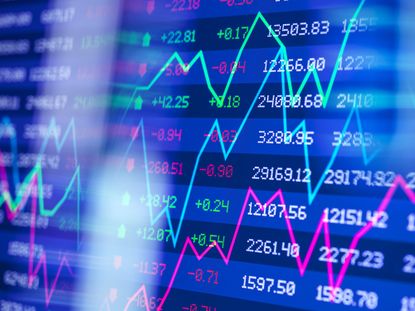For astute investors seeking to explore new avenues in the financial markets, day trading presents an intriguing opportunity.
Unlike the traditional “buy and hold” investment approach, day trading involves the buying and selling of securities within the same trading day, capitalizing on short-term price fluctuations.
In this article, we’ll take a closer look at day trading, including its fundamental principles and potential risks.
Subscribe to Kiplinger’s Personal Finance Be a smarter, better informed investor.
Save up to 74%
Sign up for Kiplinger’s Free E-Newsletters Profit and prosper with the best of expert advice on investing, taxes, retirement, personal finance and more – straight to your e-mail.
Profit and prosper with the best of expert advice – straight to your e-mail.
What is day trading? Day trading is a technique in which investors execute trades on different securities, such as stocks, currencies and options, within the same trading day. The primary objective is to capitalize on intraday price movements and profit from short-term market volatility.
Day traders employ a proactive and nimble approach, seeking to exit their positions before the trading day concludes to minimize overnight risks.
How does day trading work?To gain insight into the mechanics of day trading, let us explore its key aspects:
Research and analysis: Successful day traders begin their day by conducting thorough market research and analysis. They scrutinize market trends, news and technical indicators to identify potential trade opportunities.
Crafting a targeted portfolio: Armed with comprehensive research, day traders will curate a watchlist of potential trades with favorable risk-reward profiles, devising specific entry and exit points.
Capital allocation and risk management: Similar to long-term investing techniques, prudent day traders adhere to strict capital allocation and risk management principles. Each trade is carefully calibrated to safeguard their money while optimizing potential returns.
Sophisticated trading platforms: Day traders rely on advanced trading platforms that offer real-time data, sophisticated charting tools and seamless order execution capabilities.
Execution and monitoring: As the session starts, day traders will execute their pre-planned trades. They diligently monitor their positions throughout the day, making timely decisions based on market developments.
Adopting proven strategies: Seasoned day traders employ a range of strategies, including momentum trading, breakout trading, scalping, reversal trading and news-based trading, to capitalize on varying market conditions.
Closing positions: Before the session ends, day traders will exit all their positions, ensuring they do not carry any into the next trading session, mitigating potential overnight risks.
What are some benefits to day trading? Day trading, with its dynamic nature and potential for swift gains, holds several benefits for market participants:
Short-term profit potential: Day trading offers the possibility of realizing profits within a single trading session, providing investors with opportunities to compound returns quickly.Strategic decision-making: Successful day traders must exhibit strategic acumen, as they continuously evaluate market data and make informed decisions in real-time.Enhanced market awareness: The constant monitoring and analysis required in day trading foster a deeper understanding of market dynamics, which can help folks in their overall investment journey.Complement long-term strategies: For some investors, day trading can complement their long-term investment goals, allowing them to diversify their portfolio and capitalize on short-term market inefficiencies.What are some day trading strategies?To navigate the complexities of day trading, market participants might use the following strategies:
Momentum trading: Day traders look to ride the wave of rapidly moving assets by capitalizing on price trends that exhibit strong momentum.Breakout trading: Day traders identify key levels of support and resistance and enter trades when the price breaks out of these levels, indicating potential significant price movements.Scalping: Scalpers aim to make small, frequent profits from multiple trades during the day, taking advantage of minor price fluctuations.Reversal trading: Contrarian traders look for signs of a trend reversal and enter positions that go against the prevailing market sentiment.News-based, or event, trading: Day traders look to seize opportunities presented by significant news events that can cause price volatility.FAQs about day tradingIs day trading suitable for everyone? No. Simply put, day trading is extremely risky, and requires substantial market knowledge and a high tolerance for risk and potential losses. As such, it is not suitable for all folks, especially those with a long-term investment horizon.
Is day trading risky? This cannot be said enough: Day trading involves significant risks. These include sudden market reversals, excessive trading costs, emotional stress and the potential for major losses. Market participants must carefully consider these risks before engaging in day trading.
How much money is needed to start day trading? The amount of capital required for day trading varies based on individual strategies and risk tolerance. Most brokerages require a minimum of $25,000 to day trade in order to avoid the “pattern day trader” rule. Make sure to check with your broker to see what their specific requirements are for day traders.
Is day trading “easy”? While some folks achieve success in day trading, sustained profitability is challenging and requires continuous adaptation to market conditions, disciplined execution and sound risk management.
The bottom lineDay trading presents an avenue for savvy traders to explore short-term market dynamics and capitalize on intraday price movements. However, it is crucial to acknowledge that day trading is a high-risk endeavor that demands astute decision-making, strict risk management and a thorough understanding of market intricacies.
Related contentWhat Is the VIX?What Is VWAP?How to Start Investing In the Stock Market: A Beginner’s Guide
